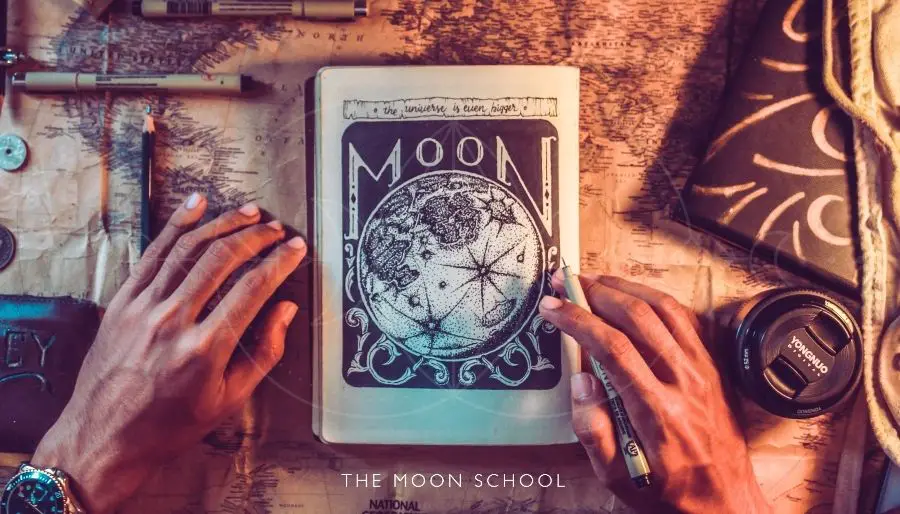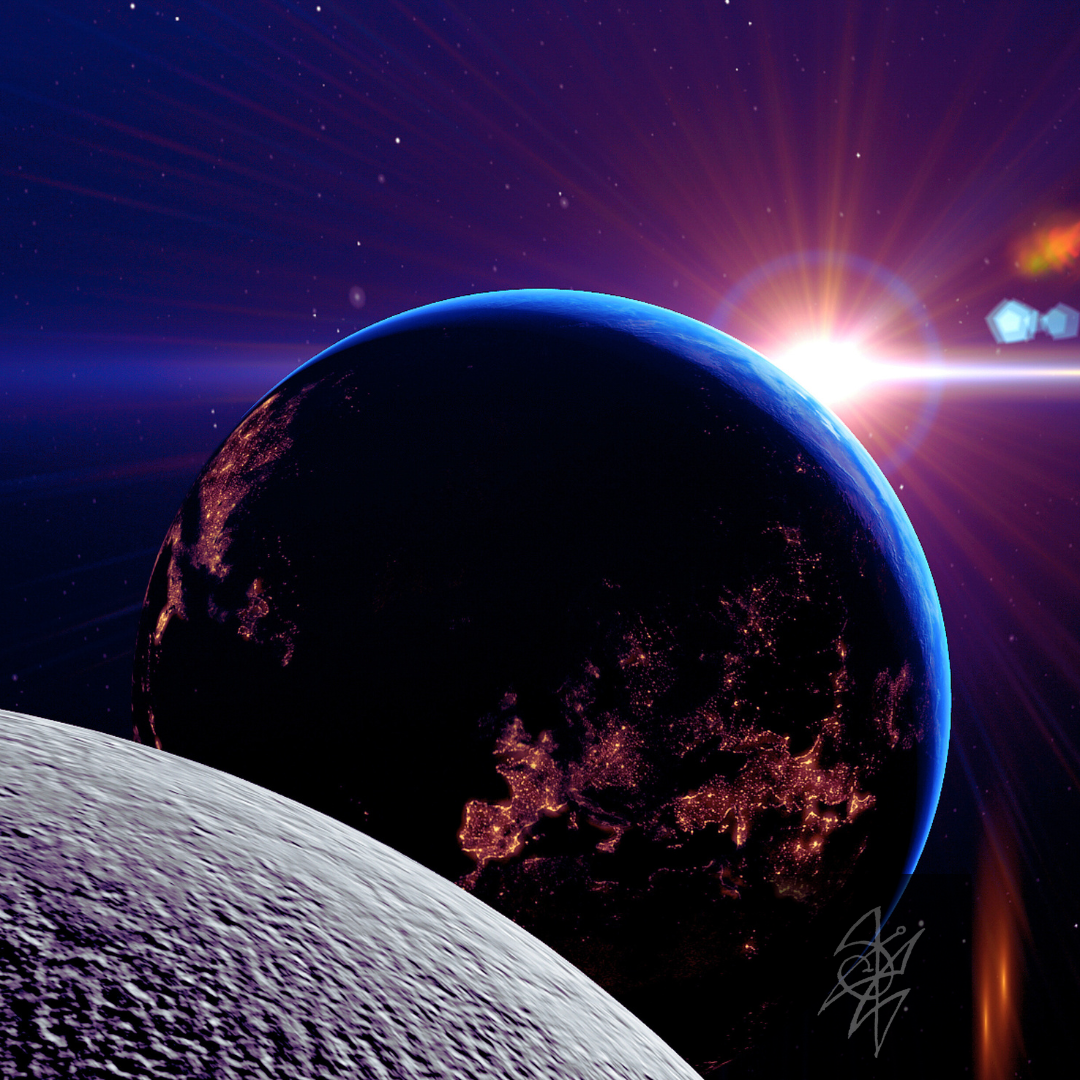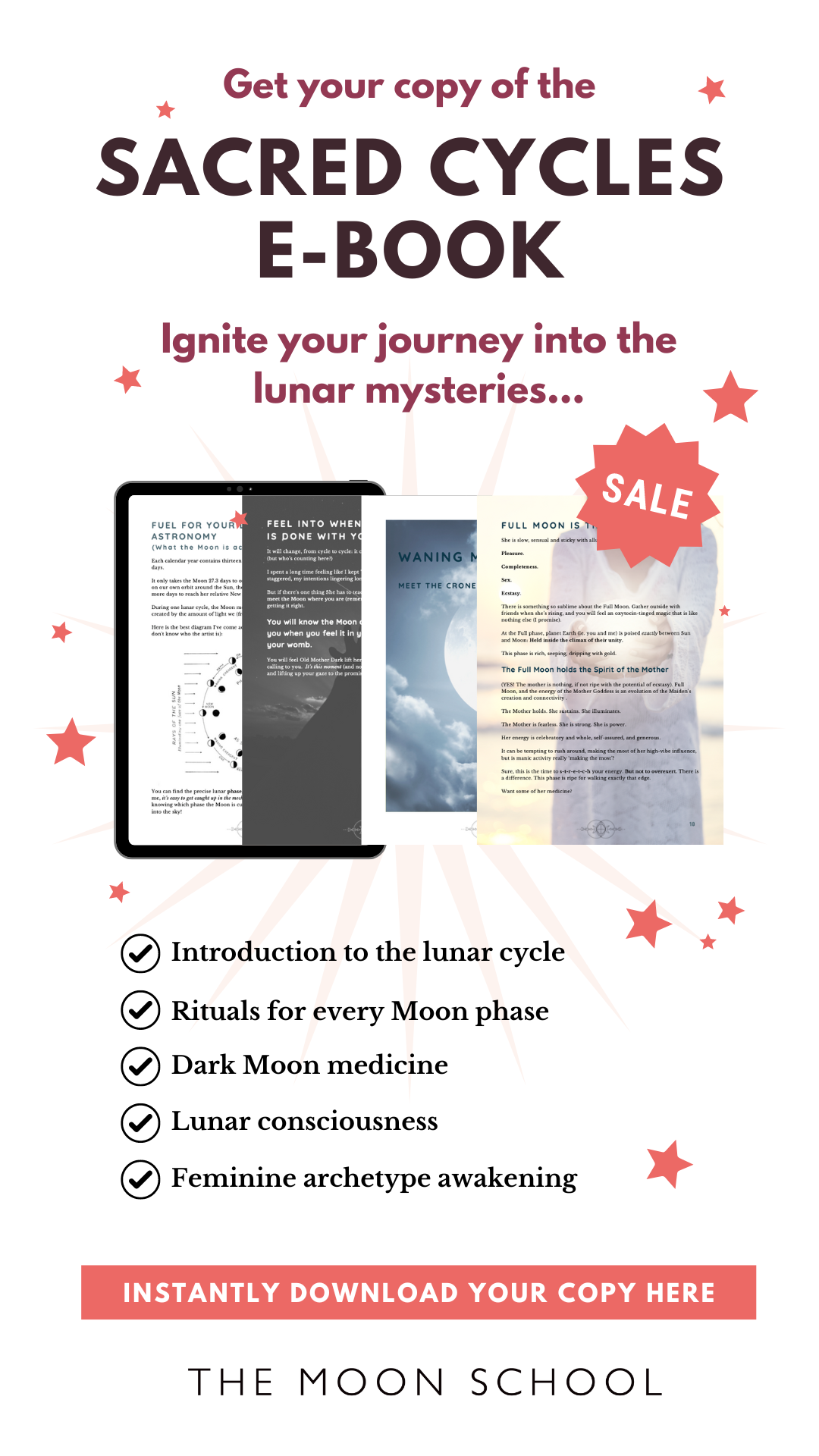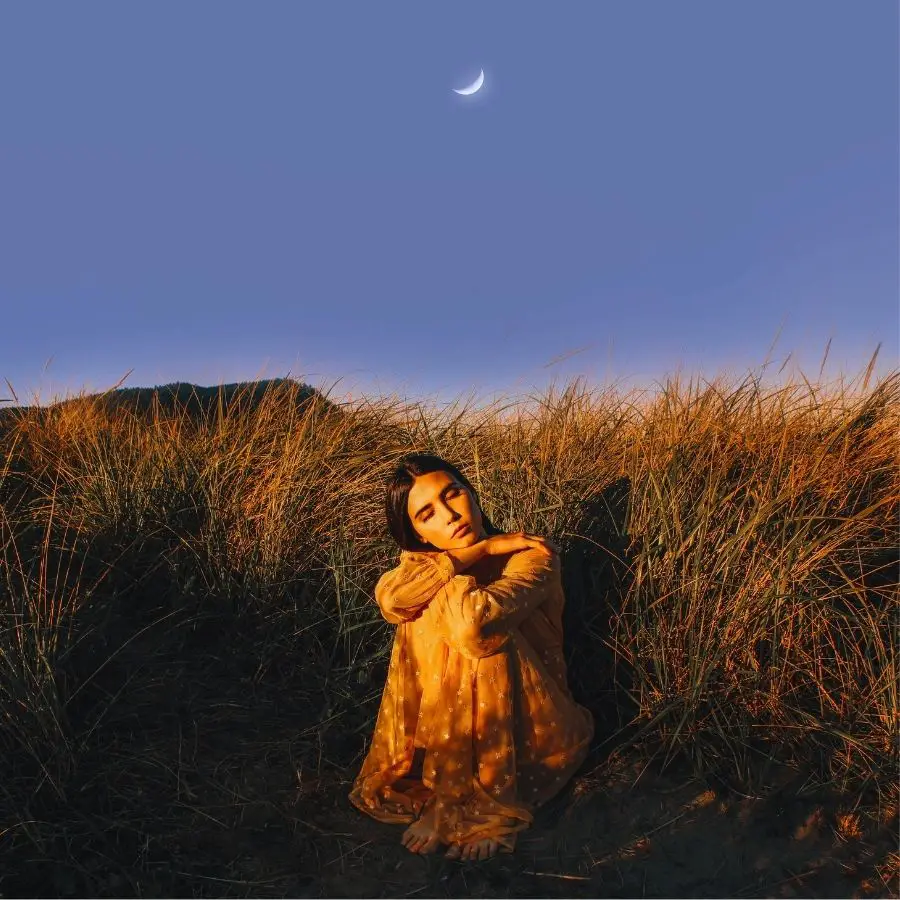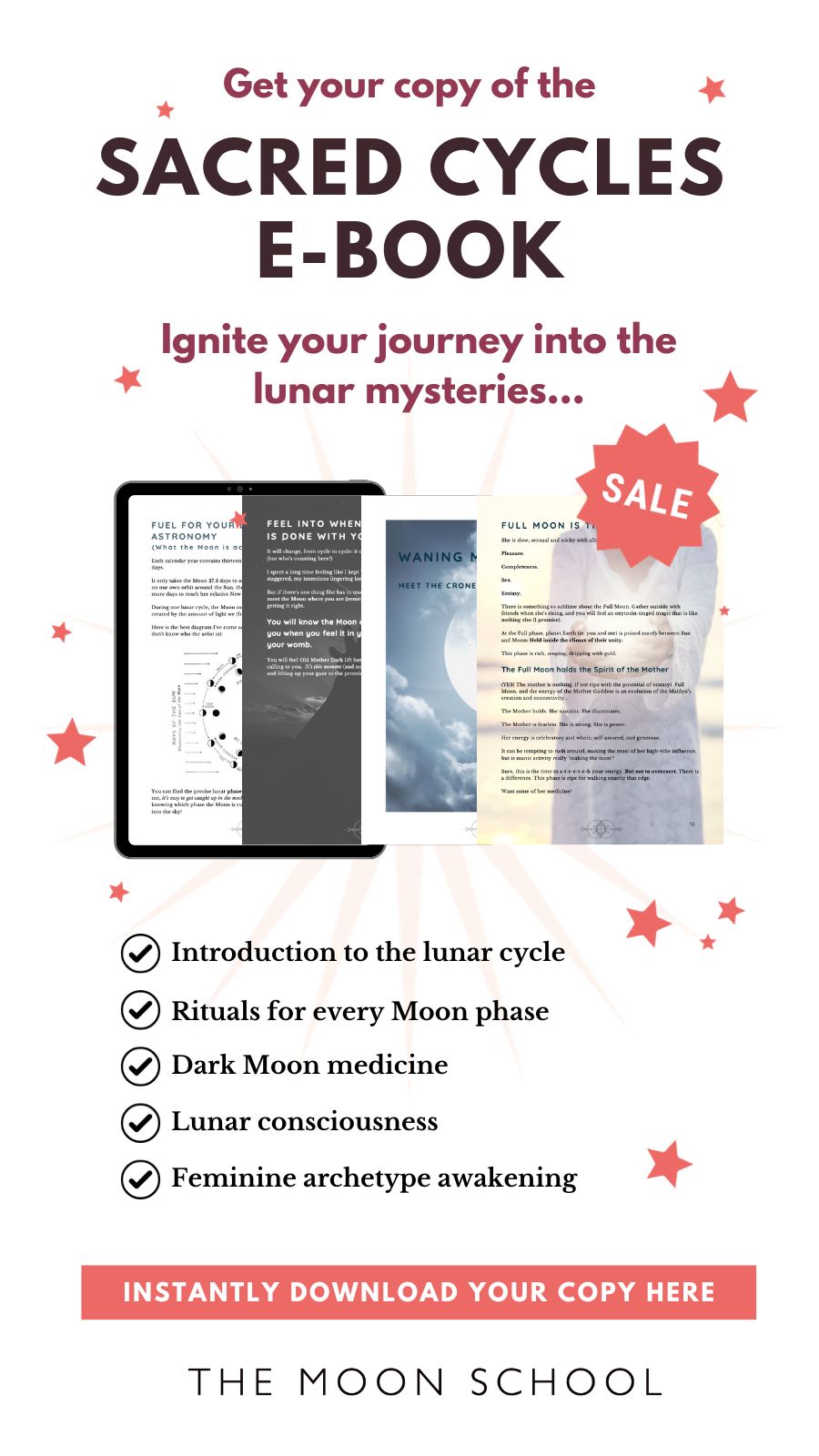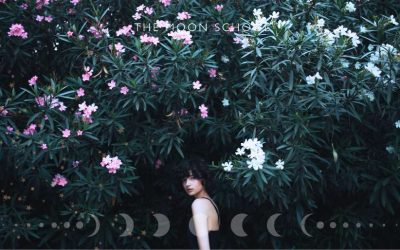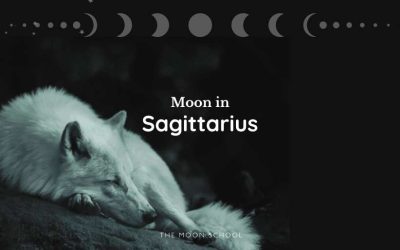What is the symbolic meaning of the Moon… to you?
The Moon is often seen as a symbol of mystery, intuition, and the subconscious mind. It’s associated with feminine energy, cycles, and transformation. In many cultures, the Moon also represents emotions, dreams, and the passage of time.
Its phases are linked to the ebb and flow of life, symbolizing growth, renewal, and the interconnectedness of all things.
As our ever-present, yet ever-changing companion, it’s no surprise that Moon symbolism has captivated the human imagination for centuries!
Across countless cultures, religions, and mythologies our celestial companion continues to embody this myriad of meanings from the Greek goddess Selene to Norse God Mani.
The enchanting beauty and mysterious presence of the Moon in our night sky continue to be a neverending source of inspiration and awe today.
If you let her, the Moon will also serve as a guiding light in your own life…
The Moon represents time
Throughout history, the Moon has been an important symbol of time. Its phases and cycles have been used as a timekeeping device to track the passage of time, the changing of the seasons, and the ebb and flow of natural processes.
As the Moon orbits Earth continuously and predictably, various cultures have utilized the Moon’s connection to the Earth and Sun to track time via Moon calendars, lunar phases, lunar cycles, lunar eclipses, and also lunar tides.
Lunar calendars
Many cultures, such as the Islamic, Jewish, and Hindu cultures, use lunar calendars to track time. These calendars are based on the cycles of the Moon, with each month beginning on the day of the new Noon or the first sighting of the crescent Moon.
Lunar phases
In addition to lunar calendars, many cultures have also used the phases of the Moon to track time. For example, the ancient Greeks used the phases of the Moon to mark the four-week intervals between their festivals.
Lunar cycles
The Moon’s cycles have also been used to track time in some cultures. For example, the Mesoamerican cultures used a 260-day calendar that was based on the moon’s cycles, with each day being associated with a specific deity.
Lunar eclipses
Lunar eclipses have been used to track time in some cultures as well. For example, the ancient Chinese used lunar eclipses to predict the future and to determine the health and longevity of the emperor.
Lunar tides
Finally, some cultures have used the tides, which are influenced by the Moon, to track time. For example, the ancient Polynesians used the tides to navigate the ocean and to determine their location.
The Moon and feminity
The Moon has long been regarded as a symbol of femininity, as it represents the nurturing, intuitive, and ever-changing aspects of feminine energy.
Its cyclical phases are often associated with the stages of a woman’s life, from maiden to mother to wise woman/crone. This is represented in the triple Moon symbol, which encompasses the waxing crescent, full and waning crescent Moon phases in one.
Goddesses associated with the Moon
Throughout history, many Moon goddesses have been revered and worshiped, representing feminine energy and aspects like fertility, creativity, and motherhood.
For example, in ancient Egypt, the Moon Goddess Isis, symbolized motherhood and protection. Similarly, in Greek mythology, Artemis, the goddess of the hunt, was associated with moonlight and the protection of young women.
Read this post next: A List of Moon Goddesses From Around the World
Moon as a symbol of the feminine
The Moon’s phases mirror the natural cycle of a woman’s fertility, making it symbolic of birth, growth, and motherhood.
The waxing and waning Moon closely mimic the menstrual cycle, empowering the connection between women and the lunar cycles. This also emphasizes the potent symbolism of fertility and the cycles of birth, life, and death, all held within the Moon.
Also read: Your Sacred Blood – What are the Red and White Moon Cycles?
With her ancient feminine personification, the Moon also serves as a reminder of the feminine side in all of us, both male and female. This includes embracing the qualities of intuition, creativity, emotion, darkness, and magic.
By connecting with the energy of la Luna, you can tap into the inner depths of your feminine essence, allowing it to flourish and illuminate your life.
The Moon and the masculine?
You might be surprised to learn that the Moon also has strong ties to masculine symbolism as well.
In various cultures and belief systems, the Moon is seen as representing the balance between masculine and feminine energies. One example of this is in ancient Chinese philosophy, where the half-moon represents the concept of yin and yang, two opposing forces that complement one another in the natural world.
Gods associate with the Moon
Sin: In ancient Mesopotamian mythology, Sin was the god of the Moon. He was often depicted as an old man with a long beard and a crescent moon on his forehead.
Mani: In Norse mythology, Mani was the god of the Moon. A man with a pale, glowing face, he was believed to ride a chariot pulled by two horses.
Overall, the moon has been associated with many different gods and goddesses in various cultures throughout history, often representing the cycles of nature, the passage of time, and the power of the universe.
The Moon as a symbol of protection
When it comes to masculine symbolism, the Moon often represents guidance and protection. For instance, the Moon’s cyclical nature is seen as a guiding force that helps navigate through life’s changes. In this sense, the Moon can be seen as embodying the strength and resilience often associated with more masculine energy.
The Moon as a symbol of the hero’s journey
Some many myths and legends feature the Moon as a symbol of the hero’s journey and personal transformation.
Representing the cycles of birth, death and renewal, The Moon’s phases make it a powerful icon for the concept of growth and becoming.
This association with personal growth can inspire you to embrace new opportunities and challenges, and to strengthen your resolve.
The Moon symbolism, water, and the tides
Another fascinating aspect of Moon symbolism is how the Moon affects the tides, water, and natural cycles.
Water levels on the shorelines are influenced by the movements of the Moon, and this is because of the gravitational pull between Earth and Moon, that causes the tides.
The ebb and flow of the tides are a perfect representation of the natural rhythms and cycles that la Luna is so often associated with.
The Moon affects not only the ocean tides but also other tide cycles in nature. The most obvious is the female menstrual tide – the ebb and flow of menstrual blood and also of other fluids, within the bodies of women.
Additionally, many cultures see the Moon as a symbol of water itself. As a nurturing and life-giving element, water is essential for our survival. The Moon’s clear and strong relationship with water deepens its symbolism of nourishment and sustenance for humanity.
More metaphorically, the waning and waxing Moon also represents the ebb and flow of our emotions.
Just as the tides rise and fall, your emotions can fluctuate, so the Moon serves as a reminder that change is a constant part of life. In fact, embracing the tides of emotional change can lead to personal growth and self-discovery.
Moon symbolism and our emotions
The Moon has long been associated with the realm of emotions.
Not only do the changing phases of the Moon symbolize the ebb and flow of human emotions, but many people experience an actual rise and fall of emotional energy during a lunar month.
Just like the menstrual flow of women, our emotional tides also hava a cyclical nature, rising and falling with the ebb and flow of the lunar phases (these are described below).
The Moon is also used as a symbolic tool in poetry and literature. The latin word for Moon is “luna” and this has become a symbol of love, longing, and the mysteries of the human heart.
In astrology, the Moon is associated with the emotional realm and is said to influence our moods, instincts, and intuition.
Moon symbolism, the unconscious, and the shadow self
The Moon has long been considered a symbol of mystery, parallelling the unseen and largely unknown landscape of the unconscious mind. This is the part of your psyche that operates without your conscious awareness, also known as the shadow self.
When the full Moon shines brightly, it is seen by some as a symbol of illumination, clarity and renewed perspective that results from exploring the unconscious mind through shadow work.
We all have a shadow, and we all have shadow traits and qualities that live there, that we have no conscious awareness of.
The symbolic illumination offered by the full Moon’s energy can help you explore the unseen depths of your psyche. This can help you to achieve self-actualization, emotional health and balance, and wholeness.
What do the Moon phases symbolize?
Perhaps the most iconic symbol of the Moon is the glowing orb of completion, which symbolizes the full Moon.
As la Luna moves through her monthly orbit around the earth, each phase of the Moon symbolizes something different
New Moon
The new Moon symbolizes new beginnings, growth, and setting intentions. It represents a time for planting seeds of intention, starting fresh, and embarking on new endeavors. At this phase the Moon appears as an almost inperceptible sliver of light, and signifies a blank canvas for manifesting dreams and aspirations.
Read more: What’s the Spiritual Meaning of the New Moon phase?
Waxing Crescent Moon
The waxing crescent phase symbolizes intention, expansion, and growth. It represents a time for building momentum, setting goals, and taking action. The increasing illumination of the crescent signifies progress and the gradual realization of aspirations and desires.
Discover: Spiritual Meaning of the Waxing Crescent Moon
First-quarter Moon
The first quarter Moon symbolizes decision-making, challenges, and perseverance. It represents a time for overcoming obstacles, making choices, and taking decisive action. The half-illuminated phase signifies a need for balance and determination in pursuing goals and addressing challenges.
Read more: Spiritual Meaning of the First Quarter Moon
Waxing gibbous Moon
The waxing gibbous Moon represents refinement, progress, and preparation. It represents a time for fine-tuning plans, making adjustments, and staying focused on goals. The nearly full illumination of this waxing Moon phase signifies the nearing culmination and the need for diligence in final preparations.
For more: Spiritual Meaning of the Waxing Gibbous Moon
Full moon
The full Moon phase symbolizes culmination, illumination, and fulfillment. It represents a time for harvest, clarity, and heightened emotions. The complete illumination of the full moon in the night sky signifies the peak of energy, realization of goals, and the expression of emotions.
Read More: What’s the Spiritual Meaning of the Full Moon?
Waning gibbous Moon
The waning gibbous Moon symbolizes gratitude, reflection, and release. It represents a time for acknowledging achievements, gaining perspective, and letting go of what no longer serves. The decreasing illumination of the gibbous phase signifies the need for introspection and gratitude before the upcoming waning phase.
Check out: Spiritual Meaning of the Waning Gibbous Moon
Last-quarter Moon
The last quarter Moon signifies reassessment, release, and transition. It represents a time for evaluating progress, releasing what no longer serves, and preparing for change. The half-moon signifies the need for introspection and making peace with transitions.
Discover more: Spiritual Meaning of the Last Quarter Moon
Waning crescent Moon (or balsamic Moon)
The waning crescent Moon symbolizes surrender, reflection, and renewal. It represents a time for letting go, inner reflection, and spiritual cleansing. The decreasing illumination of the crescent signifies the need for introspection and preparing for the upcoming new moon phase.
Discover more: Spiritual Meaning of the Waning Crescent Moon
Dark Moon
The dark moon symbolizes introspection, release, and renewal. It represents a time for deep reflection, shedding old patterns, and preparing for new beginnings. The absence of illumination signifies a period of inner transformation and the potential for rebirth.
Read more: What’s the Meaning of the Dark Moon Phase?
Understanding the symbolism of the different Moon phases can really open you up to the possibilities of life! It can help you align your actions and intentions with the natural rhythms of the lunar cycle, synching up with Mother nature herself.
By paying attention to these phases, you can harness their energies and enhance your personal growth and well-being.

